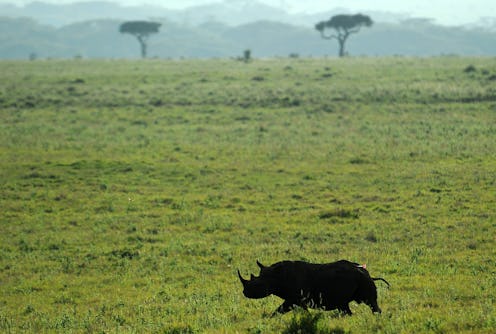News
Wounded Rhino Saved With Elephant Skin
Finally, there's some happy news for animal rights activists. After weeks of tragic reports, conservationists were thrilled when a 12-year-old rhino wounded by poachers was saved with elephant skin bandages after having her front horn hacked away by poachers. The rhino, Ithemba, hails from a South African wildlife park near the KwaZulu-Natal province and was first attacked on August 5. Ithemba overcame nearly insurmountable odds to make it even this far — fitting for a rhino whose name means "hope" in Zulu. With these new bandages, doctors said, Ithemba's situation grows more promising with each passing day.
"The front horn was hacked off, and they started with the back horn as well, but then either got disturbed or the rhino got up," explained University of Pretoria wildlife surgeon Dr. Johan Marais, in a statement to the Associated Press on Saturday. Marais joked that it was "ironic" that doctors would be using the skin from one endangered species to save another.
"We [were] looking for a material that’s strong, lightweight but pliable," said Marais. The skin, he clarified, had come from an elephant that died of natural causes. The skin was the perfect match for Ithemba.
"I decided with this rhino to make use of elephant skin, as it is quite tough, and hope it will withstand the rubbing efforts of the rhino and the stainless steel sutures we used to fasten the skin on to the rhino's face," added Marais, in a comment to CNN.
As with most wild animals, said Marais, there's no way to appropriately administer any sort of post-operative care — so they had to make sure they got it right the first time. So far, he said, things were looking up.
The South African Department of Environmental Affairs reported earlier this year that nearly 400 rhinos had been killed by poachers between January and April alone. In 2014, the number of total rhinos poached numbered over 1200, or as conservation group Save the Rhinos put it, "one every eight hours." Most, if not all, were killed solely for the two ivory horns on their faces.
In May, South African environment minister Edna Molewa expressed grave concern over the jump in numbers, promising to dedicate more time to the cause going forward.
"We are soldiering on," said Molewa. "We do think that this fight will have to be won and we will win it."
In the hours after Cecil the lion's death hit headlines, the public grew increasingly invested in the conservation movement, with many protesting the hunter who shot him, Minnesota dentist Walt Palmer. Just days later, erroneous reports that Cecil's brother, Jericho, had also been killed began to spread across social media. Those reports were later dismissed by the scientists in charge of tracking Jericho, although they explained that the uproar was not wholly unwarranted, given that a second lion had indeed been illegally hunted and killed (by another American tourist, no less).
On July 26, Kenya Wildlife officials also reported that five elephants from Tsavo West National Park had been killed by poachers and had their tusks hacked away as well — tusks which, like Ithemba's horns, can be sold at market for around $1,000 per pound (officials have estimated that the illegal poaching industry in Congo is valued at around $7 to $10 billion annually; The practice is so lucrative, even terrorist groups have jumped into the mix).
"It's just devastating ... it took us completely by surprise," said spokesman Paul Gathitu, mourning the loss of the mother elephant and her four offspring.
It's been a terrible year so far for wildlife lovers, but hopefully, with the reports of Ithemba the rhino's successful elephant-skin surgery, things have turned a more a positive corner. In the coming days, as Ithemba's infection shields are removed and her wounds begin to heal, conservationists are hoping for even more reasons to celebrate.
